Know the Beard Basics to a Terrific Trim
Once you have made the decision to start growing a beard, you will have taken your first step into the wild and wonderful world of facial hair. Very soon, however, you will find that while facial hair may grow very easily, it takes a bit of work to keep it healthy and looking its best. You will soon discover that regular beard trimming is one of the most important things you can do to keep your beard looking bold and beautiful.
- Know the Beard Basics to a Terrific Trim
- Why You Should Trim Your Beard
- Determining If a Barber Should Trim Your Beard
- When To Start Trimming Your Beard
- How Often You Need To Trim Your Beard
- Beard-Trimming FAQ
- Tools You Will Need To Trim Your Beard at Home
- Essential Beard Care Basics: Establishing Your Neckline
- Essential Beard Care Basics: Establishing Your Cheek Line
- Preparing to Trim Your Beard
- Do’s and Don’ts When Preparing to Trim Your Beard
- Steps To Trimming a Short Beard at Home
- Steps To Trimming a Medium or Long Beard at Home
- Steps To Trimming a Mustache at Home
- Weekly or Biweekly Maintenance Trimming
- The Benefits of the “Patient Trimmer” Method
- Conclusion
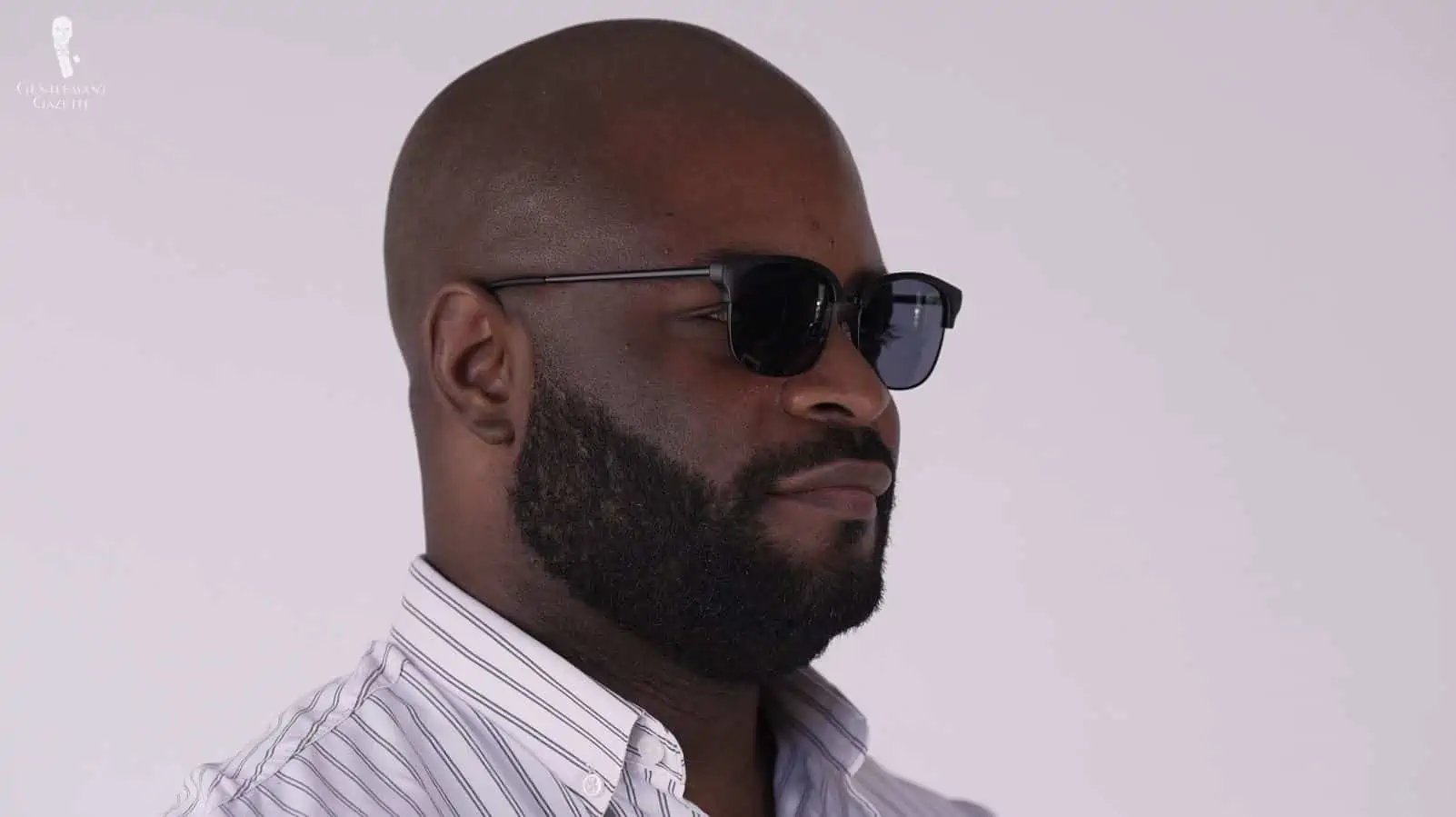
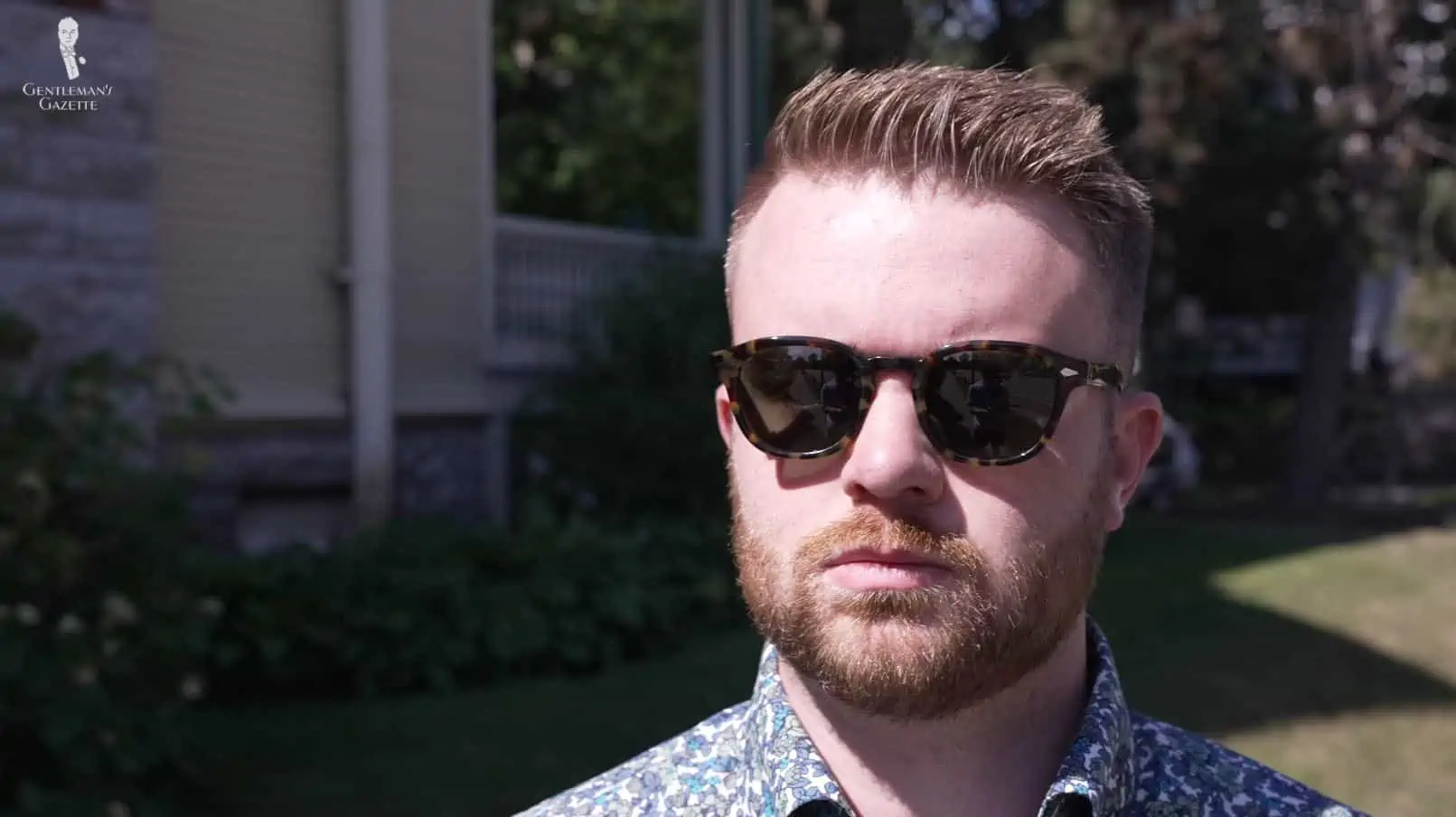
This guide provides you with all of the information you will need to trim a beard of anything length, be it short, medium, or long. We will introduce you to the tools, tactics, and trimming steps necessary to maintain an effortlessly elegant, classically coiffed, and meticulously managed beard.
Master beard basics with our Beard & Facial Hair Guide
Why You Should Trim Your Beard
| It’s Good for Beard Health | It’s Helpful for Beard Growth | It’s In Keeping with the Classic Style |
|---|---|---|
| Whether your beard is only a month old or you have been growing it for years, taking the time to neatly trim its edges will help keep your beard neat and tidy. Encouraging symmetrical growth makes it easier to comb and brush a beard, removing contaminating oils, detritus, and other pollutants that do not belong in your luscious lockes. | Believe it or not, your facial hair can have split ends, just like the hair on your heard. Split ends not only look unappealing, they often adversely affect the overall health of the hair follicle. By removing split ends through regularly trimming, you will be improving the overall health of your beard hairs, which often contributes to faster, more dense growth, improving the overall appearance of your beard. | Devotees of the Classic Style know that while we may love beards today, they were not very popular during the Golden Age of Menswear. Most Classic Style aficionados of the 1920s to early 1960s were clean-shaved or had silky mustaches. However, their facial hair choices do not mean that a beard is incompatible with the Classic Style. By maintaining an elegant and neatly trimmed beard, you will closely approximate the sleek, refined aesthetics of the Golden Age of Menswear even while wearing a beard. |
Determining If a Barber Should Trim Your Beard
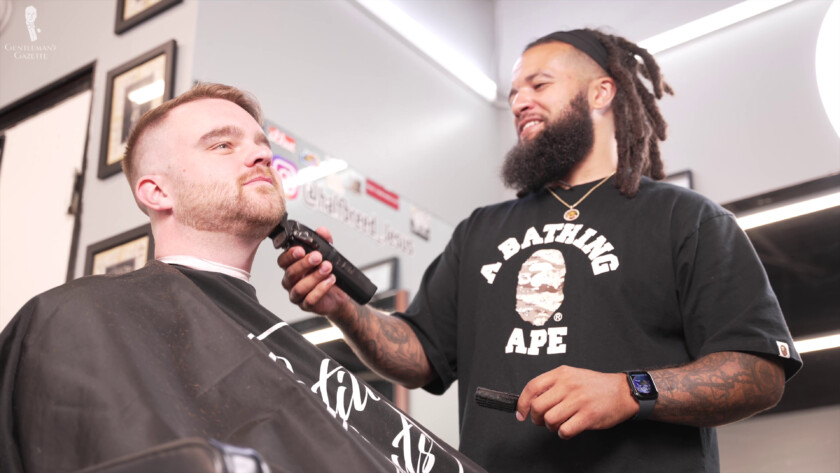
Weighing the Pros and Cons
Under most circumstances, few gentlemen today would say that men ought to cut the hair on their heads themselves. Because your beard hair is front and center and much easier for you to access, however, trimming it at home is much more viable.
A professional barber who specializes in beard care will be able to promptly and elegantly trim your beard, as well as styling it to perfection. However, to keep your beard looking its best, you will likely require regular trimming, and numerous visits to the barber can quickly become expensive. You will also need to make appointments that might not be convenient, especially if you have an unexpected event for which you want your beard to look its best.
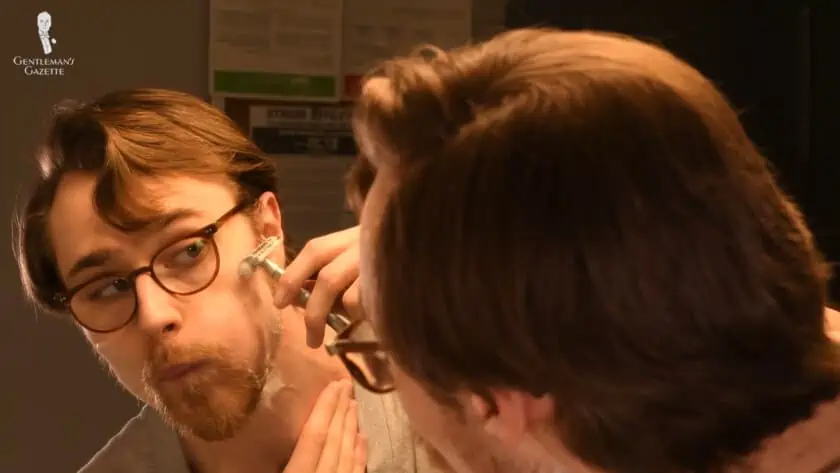
Therefore, it makes more sense for most men to learn how to do the basics of a beard trim at home, even if they also visit their barber for semi-regular trims or cuts. Not only will this approach be cheaper and more convenient, it will also allow you to touch up your beard as needed without having to rely on a professional barber. Many gentlemen who have invested time in growing their beards also prefer to handle trimming themselves, as they know exactly how they like their beards to look.
Learn 18 More Things Your Barber Wants You To Know
When To Start Trimming Your Beard
Let Your Beard Grow Before Trimming It
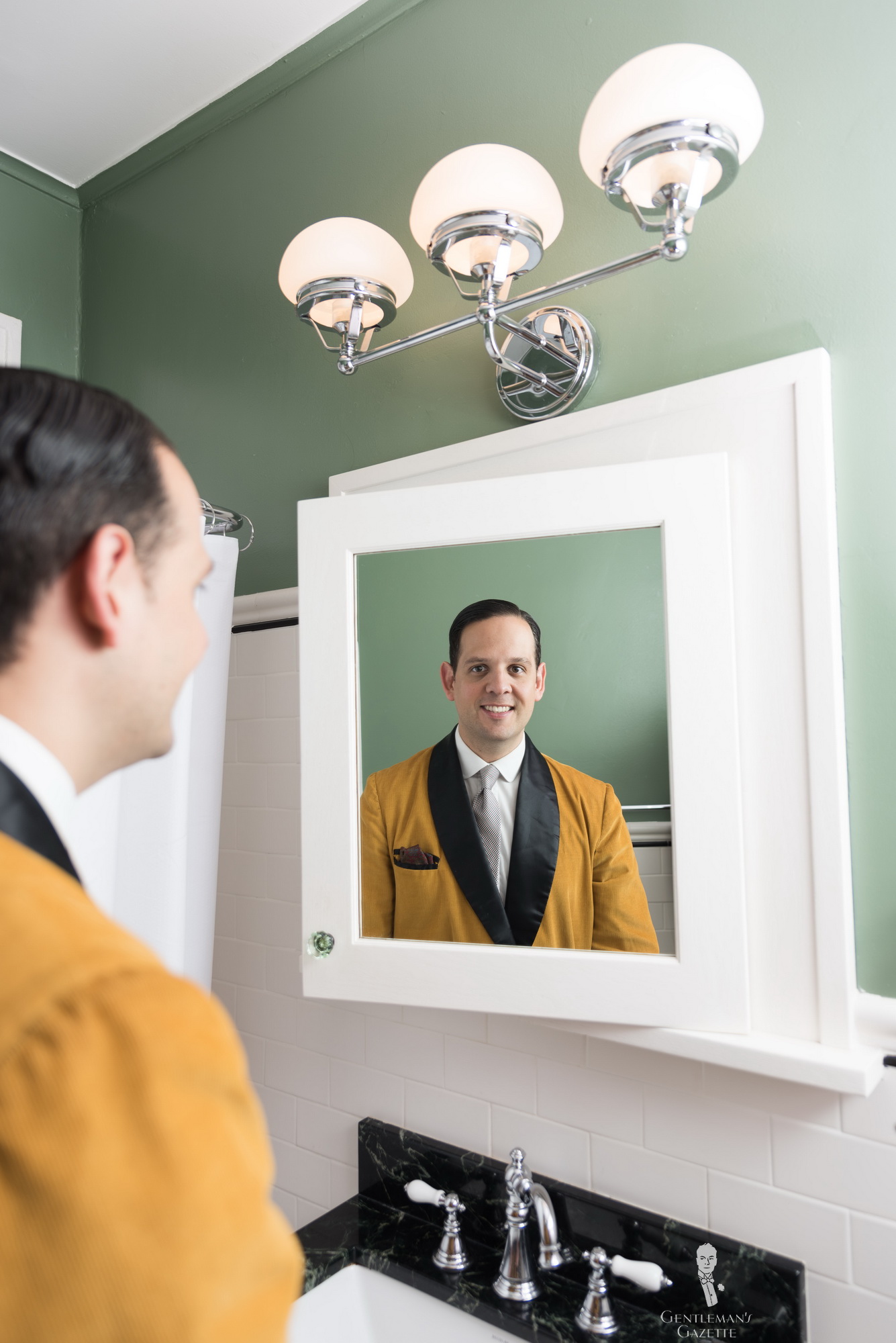
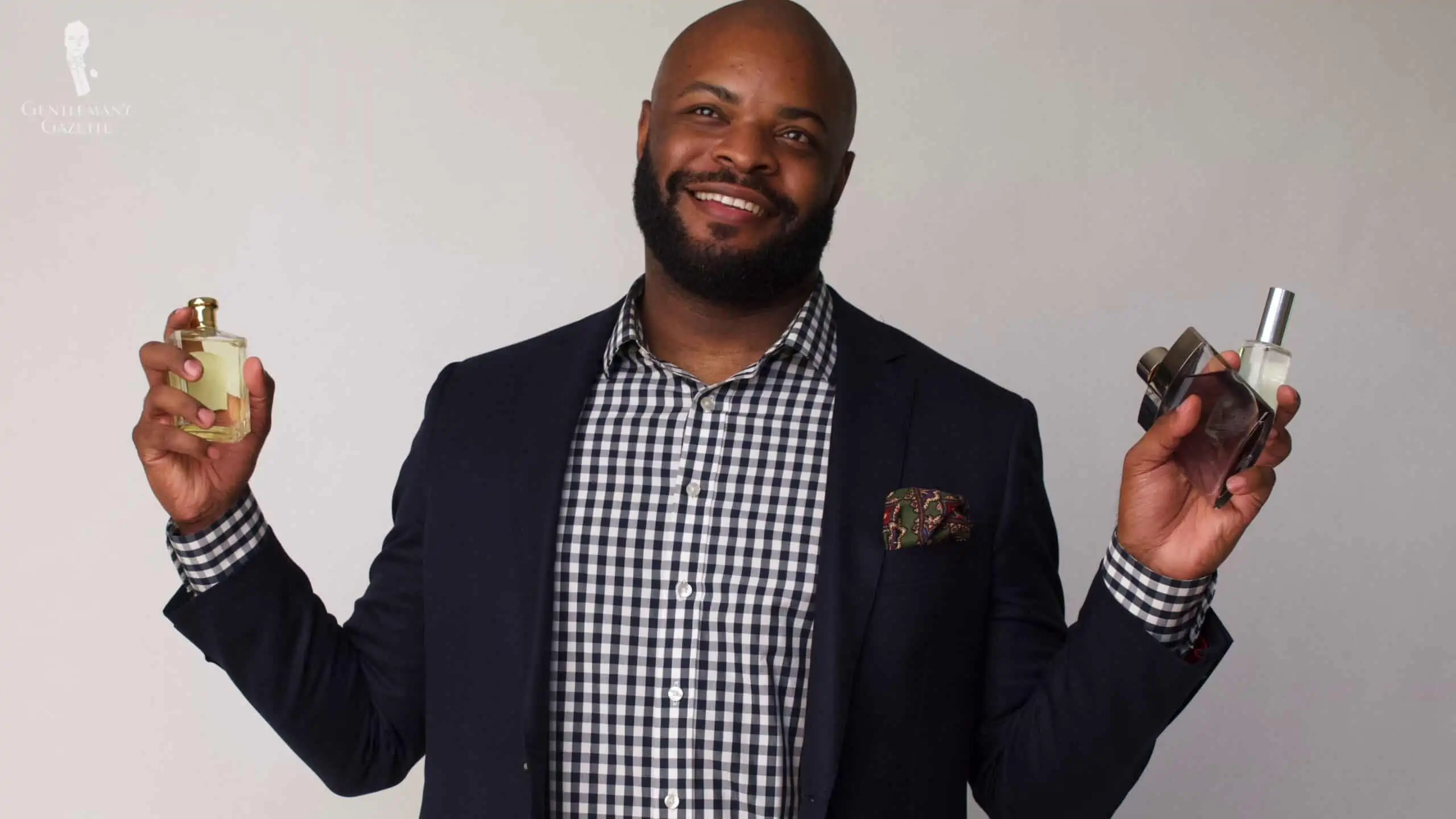
It stands to reason that in order to trim your beard, you must first let it grow. Many gentlemen, however, are tempted to begin the trimming process too early, hoping to even out patchy areas or smooth the rougher hairs typical of new growth.
But the fact of the matter is that beginning the trimming process too early can adversely affect your beard growth. Therefore, for the first two to four weeks of beard growth, you should leave your facial hair alone.
By allowing your beard and mustache to grow in fully before trimming, you will significantly reduce the number of patchy areas and ensure an overall fuller appearance, making it easier to trim your beard and ensuring that it looks its best.
Brush up on your shaving skills while waiting for your beard to grow with our dedicated Shaving Guide.

How Often You Need To Trim Your Beard
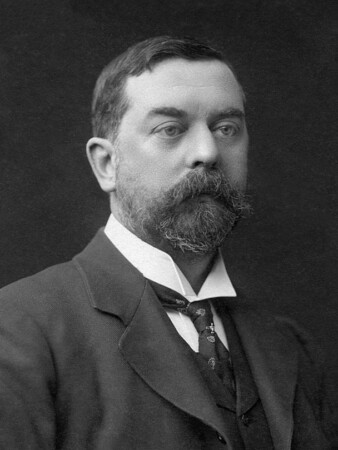
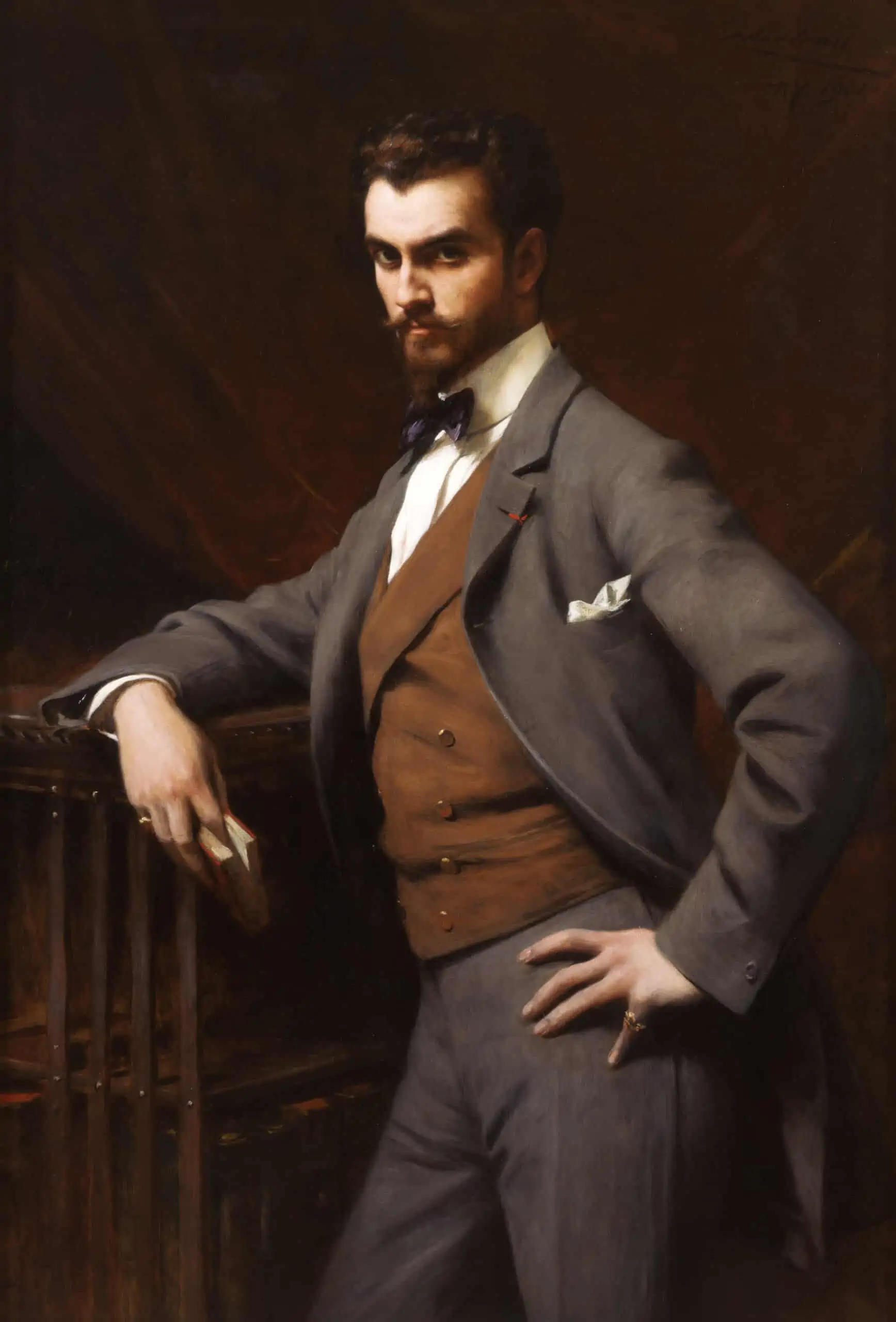
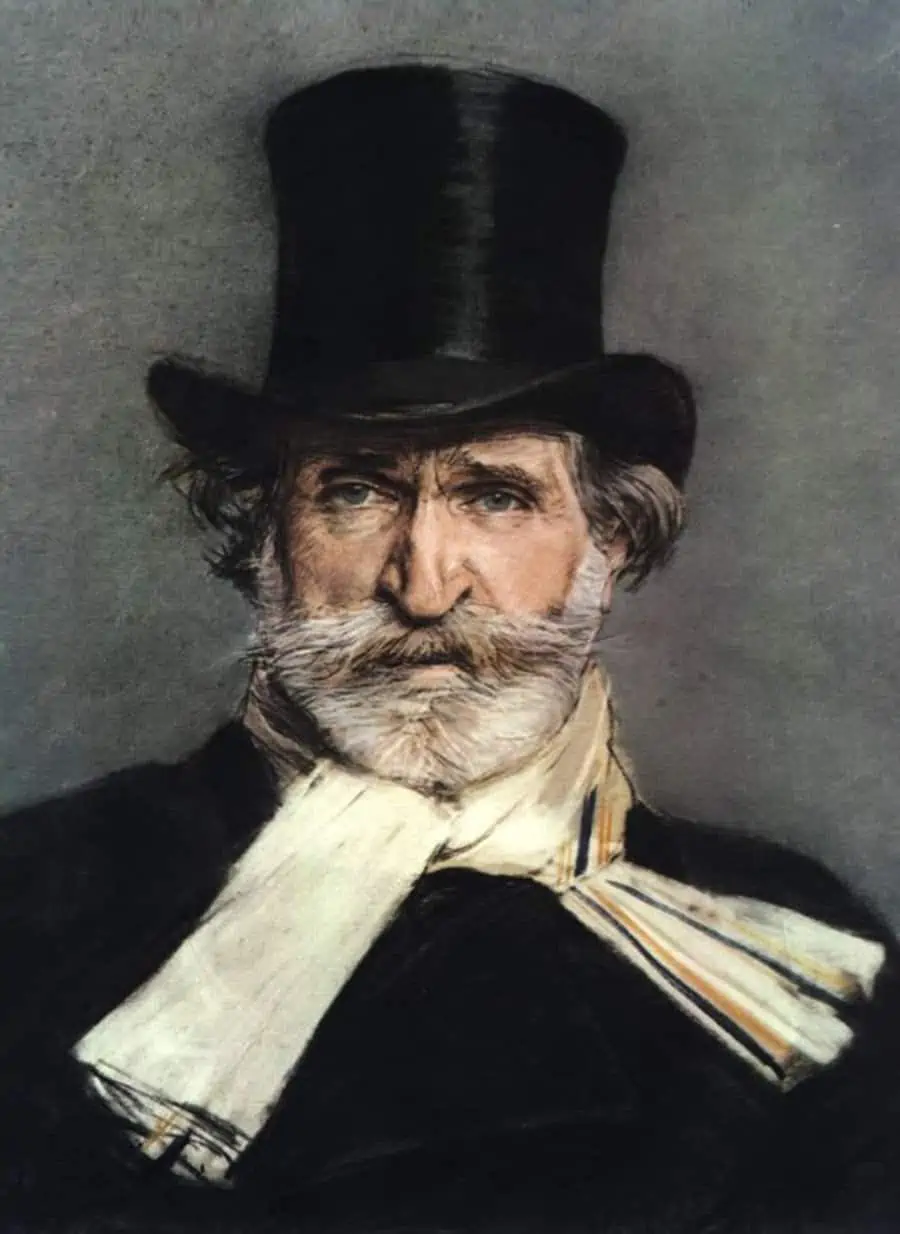
Ultimately, how often you need to trim your beard will depend on your personal style. If you like a slightly more casual, bushier beard, a trim every month or two, or even less often, may be perfectly acceptable. On the other hand, if you prefer an extremely neat, tidy beard, you may benefit from a trim every week.
The main factor in determining how often you need to trim your beard will be how quickly your beard grows and how long you want it to be: obviously if you prefer a shorter beard but have fast-growing hair, you will need to trim more often.
You can reduce the number of required major trimming sessions by practicing regular “mini-trimming” maintenance sessions. You will find the steps for these maintenance sessions outlined below.
Beard-Trimming FAQ
Is it worth it to trim your beard?
Yes, in almost all cases. Unless you like the look of a wild and scraggly beard, a trimmed beard will not only look more appealing because it is neat and elegant, it will also have better overall health.
Can you trim a beard at home?
Yes, you can! With just a few simple tools and the techniques outlined in this guide, you can easily trim your beard at home and keep it looking great.
Should I trim my beard at home or have a barber do it?
There are pros and cons to both options, but you should at least be familiar with the basics of trimming your beard for situations when you can’t easily access your barber.
What tools do I need to trim my beard at home?
You will need a beard trimmer, beard shears, a beard brush, and likely, a beard comb.
What is the best brand of beard trimmer?
The best trimmer will vary based on your hair type and needs, but we here at the Gentleman’s Gazette use Remington, Andis, and Brio beard trimmers.
How long should I wait before trimming my beard?
You should wait at least two weeks before trimming your growth of your beard around your lips and neckline. You should wait at least four weeks before trimming the body of your beard.
How often should I trim my beard?
In short, you should trim your beard as often you feel you need to to ensure a neat, elegant appearance that you like. For most gentlemen, this will require light touch-ups every few days.
What distinguishes short, medium, and long beards?
Apparent beard length varies based on your facial hair texture and how the beard is styled. In general, however, short beards are less than 1 inch / 2.5 centimeters, medium beards are longer than 2 inches / 5 centimeters and long beards are over 3.5 inches / 8.5 centimeters.
What is the best beard length?
Ultimately, beard length is a matter of personal preference, but the beards most typical of Classic Style will usually be shorter than 4 inches / 10 centimeters. However, if neatly coiffed, beards of any length can function well within the Classic Style.
I thought that facial hair was not part of Classic Style?
While it is true that facial hair other than sleek mustaches was rare during the Golden Age of Menswear, any kind of facial hair can be integrated into the Classic Style today. All that matters is that the hair is attentively cared for, neat, and refined in its styling.
How do I avoid getting a “neckbeard?”
To avoid a neckbeard, you need to shave all of the hairs that grow below your neck crease. Find out how to determine this area exactly in this guide.
Tools You Will Need To Trim Your Beard at Home
The Right Tools Make Every Job Easier
Contrary to what you might assume, you will not need a salon’s worth of supplies to trim your beard at home. In fact, you can do it with just a couple of essential tools. The addition of more products, however, can make the job easier and the final results all the more impressive.
Find our full list of beard products and tools here!
Essential Tools
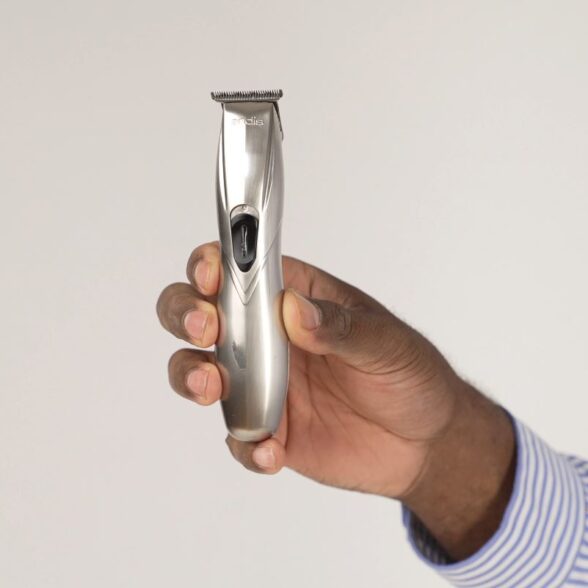
Beard Trimmer
A beard trimmer is a powered appliance with a cutting edge that quickly and efficiently removes beard hair. Beard trimmers come with guards that can be swapped out to control the length at which beard hairs are cut. All that you need to do is put on the desired guard and run the trimmer through your hair to cut your beard to the specified length. Beard trimmers are favored by many gentlemen because they are easy to operate. They are also especially adept at trimming short beards that tend to be evenly layered throughout. Beard trimmers may be too bulky, however, for some more precise trimming, necessitating the use of beard shears.
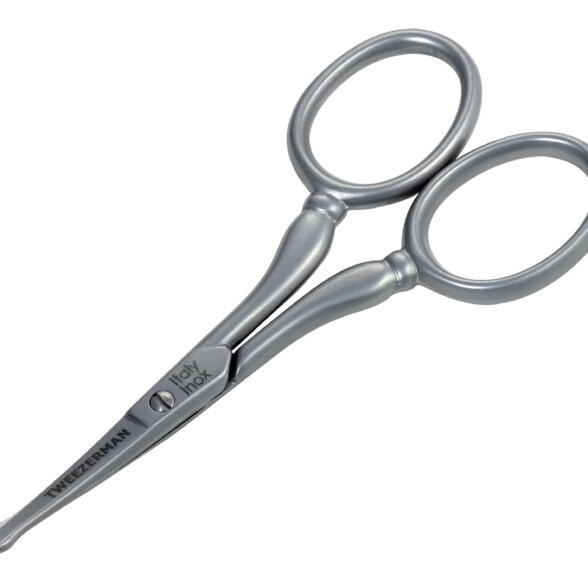
Beard Shears
Beard shears are special scissors designed to cut beard hairs. They have shorter blades, allowing for more precise control when cutting fine beard hairs. While not technically essential for short beards, all beard-wearers will benefit from the use of beard shears to snip outlying flyaway hairs that jut out of the mass of your beard.
Many gentlemen with medium or long beards also prefer using beard shears when trimming their beard because it allows them greater overall control than using even a beard trimmer. In particular, beard shears reduce the likelihood of catastrophic errors. It’s incredibly easy to unintentionally move your hand left when you intend to move right while looking at yourself in the mirror. One false move means you’ll inadvertently take a chunk out of your beard in a split second if attempting a trim with a trimmer with the guard removed.
Therefore, when making minor adjustments like cutting flyaway hairs, you are best served with a beard shear, and some gentlemen may prefer to use beard shears for the bulk of their trimming.
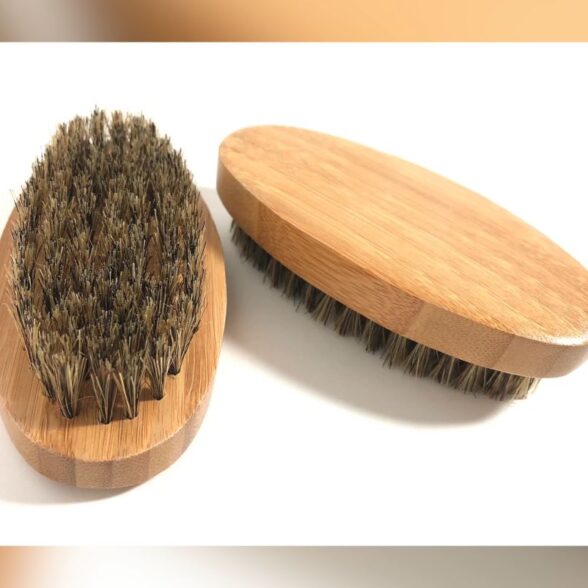
Beard Brush
Curled, bent hairs are difficult to cut and will often appear uneven if trimmed when not straight. Brushing out your beard before trimming will ensure that hairs lay flat and even. These hairs will be easier to cut, and it will be simpler for you to visualize how you need to cut the hairs to achieve your desired look.
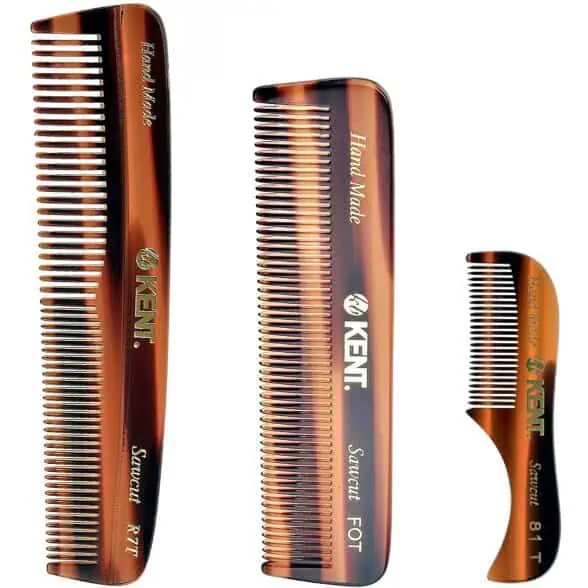
Beard Comb
If you have a medium or a long beard, it may take a very long time to brush out the full length of your facial hair with a brush alone. A beard comb, used with a brush, will ensure that your entire beard is adequately straightened and laid flat before the trimming process in a timely and efficient manner.
Beneficial Tools
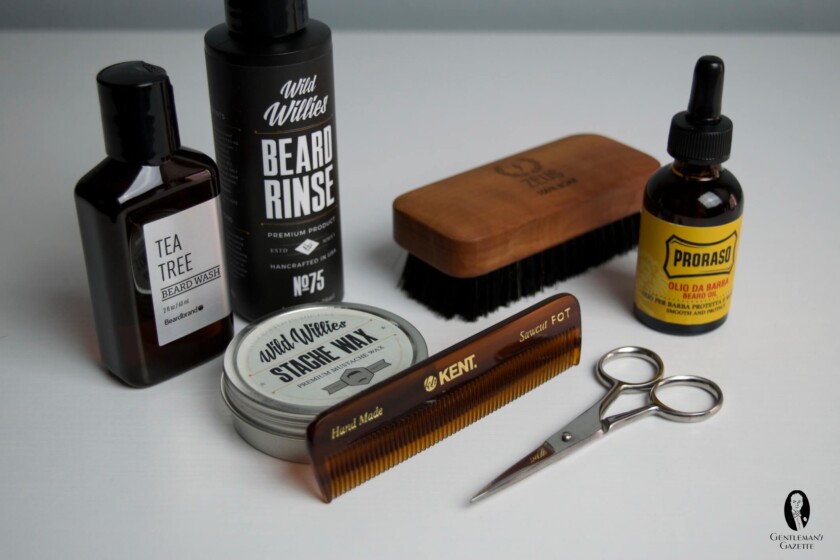
Products designed to detangle, soften, and hydrate your facial hair will help expedite the trimming process and improve the overall look and health of your beard. While not technically essential, you will reap considerable benefits from utilizing beard washes, softeners, and oils prior to trimming your beard as part of your regular beard care regimen.
Likewise, a small stand mirror, in addition to your larger mirror, will allow you to more easily see what you are doing and how your beard looks, especially if your beard is larger or longer.
Check out our friends at Beardbrand
for top-quality tools and products!
Essential Beard Care Basics: Establishing Your Neckline
A Good Neckline is the Start of a Good Beard
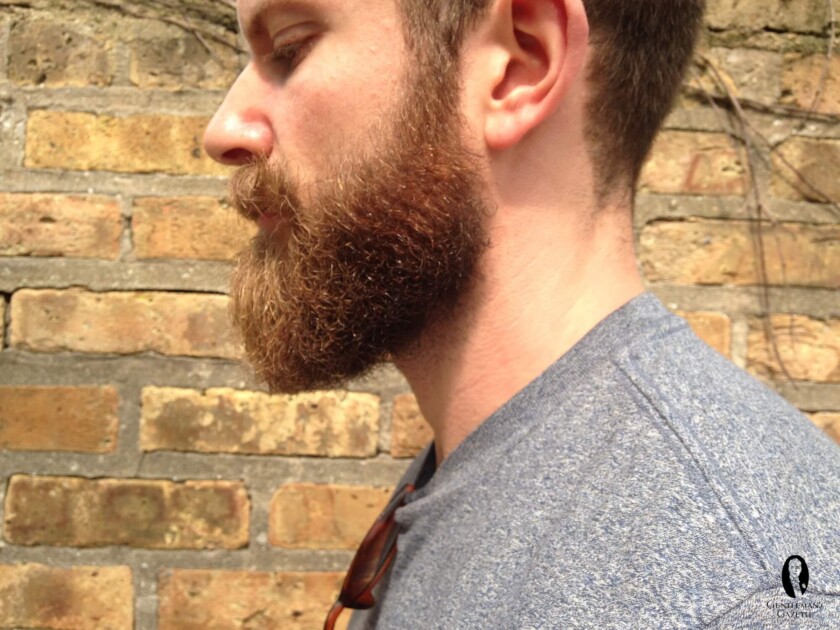
One of the first steps in caring for a newly grown beard is to establish your neckline, by which we mean the edge of your beard bounded by your jaw and neck. A clean, well-kept neckline is essential to maintaining an elegant, refined beard.
You should establish your neckline about two to four weeks after you start growing your beard, depending on your growth rate. You will know it is time to cut in your neckline when you notice regular growth of beard hairs spreading below your neck crease.
Note that many gentlemen, fearful of looking like the dreaded “neckbeard,” cut their necklines too far up, resulting in an unnatural neckline that is distracting and not flattering. Therefore, it is essential that you determine your natural neckline before cutting to guarantee a look that is appealing and organic.
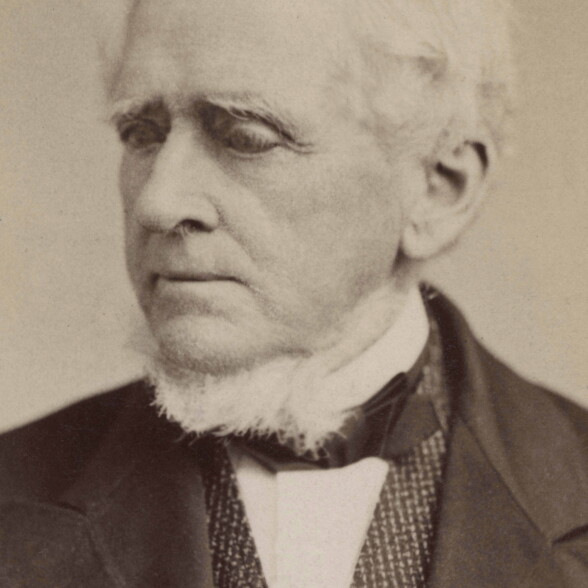
Beware the dreaded
Neckbeard
While 19th century American politician and military officer John Adams Dix, pictured to the left, clearly liked his neck beard, today, most men prefer to keep facial hair off of their necks for fearing of appearing unkempt or slovenly. Bear in mind, however, that in attempting to avoid a neckbeard, you can inadvertently cut your neckline too far up, creating a no less unappealing look.
For a full beard, your neckline will curve down from under your ear to just above your Adam’s apple, back up to the other ear; at no point should the neckline go anywhere near your chin. This feels counterintuitive at first and may even appear odd when looking at yourself in the mirror, but it is the most complementary shape you can make.
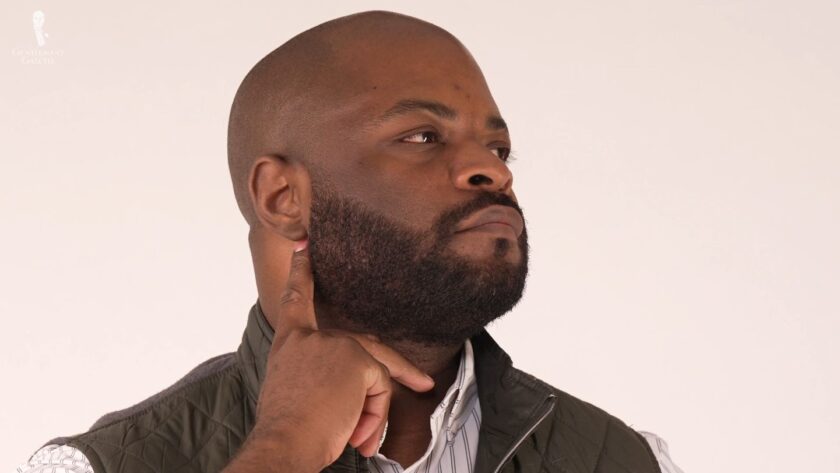
Finding and Cutting In Your Neckline
- To find your neckline, hold your hand under your chin with your palm facing and parallel to the floor.
- Pat the back of your hand underneath your jaw. Anyplace the back of your hand touches, while your palm is still facing the floor, should be left bearded.
- Now turn your hand so that your palm is facing the wall opposite you and the back of your hand facing your neck.
- Pat the back of your hand on your neck. Anywhere the back of your can make contact with your neck is safe to shave.
- If your beard hair is short enough, you can shave away these hairs with a razor. If they are longer, you can remove them with the beard trimmer with no guard attached

If You Mess Up
Especially if you are new to beard care, it can be very easy to cut in a neckline that is too high. Fortunately, this issue is easily remedied. Simply wait for the hairs to grow back in and then make another effort. Of course, if you cut in a neckline that is too low, you can fix it by simply removing additional hair.
Learn how to fade your neckline!
Essential Beard Care Basics: Establishing Your Cheek Line
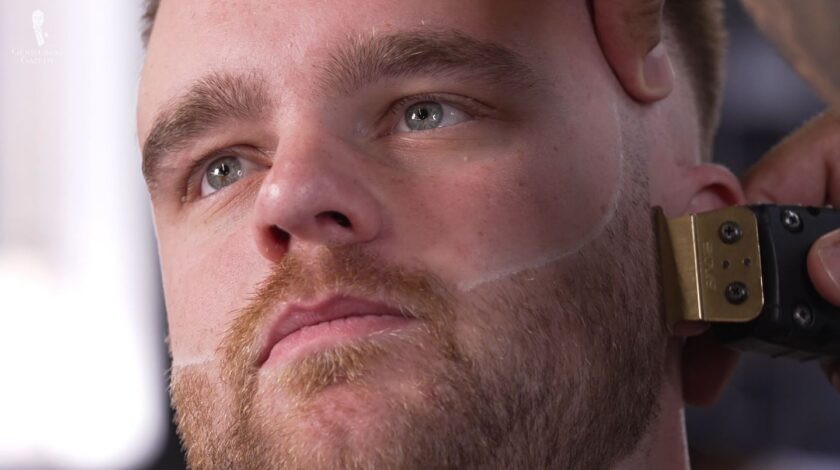
While often overlooked, your cheek line is as important for overall beard appearance as your neckline. After all, a beard that is rough around any of its edges can give the impression of a lack of grooming, while clearly defined lines showcase your beard as a well-considered addition to your overall look.
The cheek line refers to the edges of your beard on both sides of the face at the cheeks. Many modern men cut in their cheek lines too low and with unnaturally straight lines, which looks overly affected and unappealing. An organic cheek line, however, appears dapper and relaxed while still providing structure to your overall beard.
You should begin cutting in your check line four to six weeks after beginning to grow your beard. As with your neckline, your sign to begin work will be when the hairs are noticeably intruding too high on your cheek.
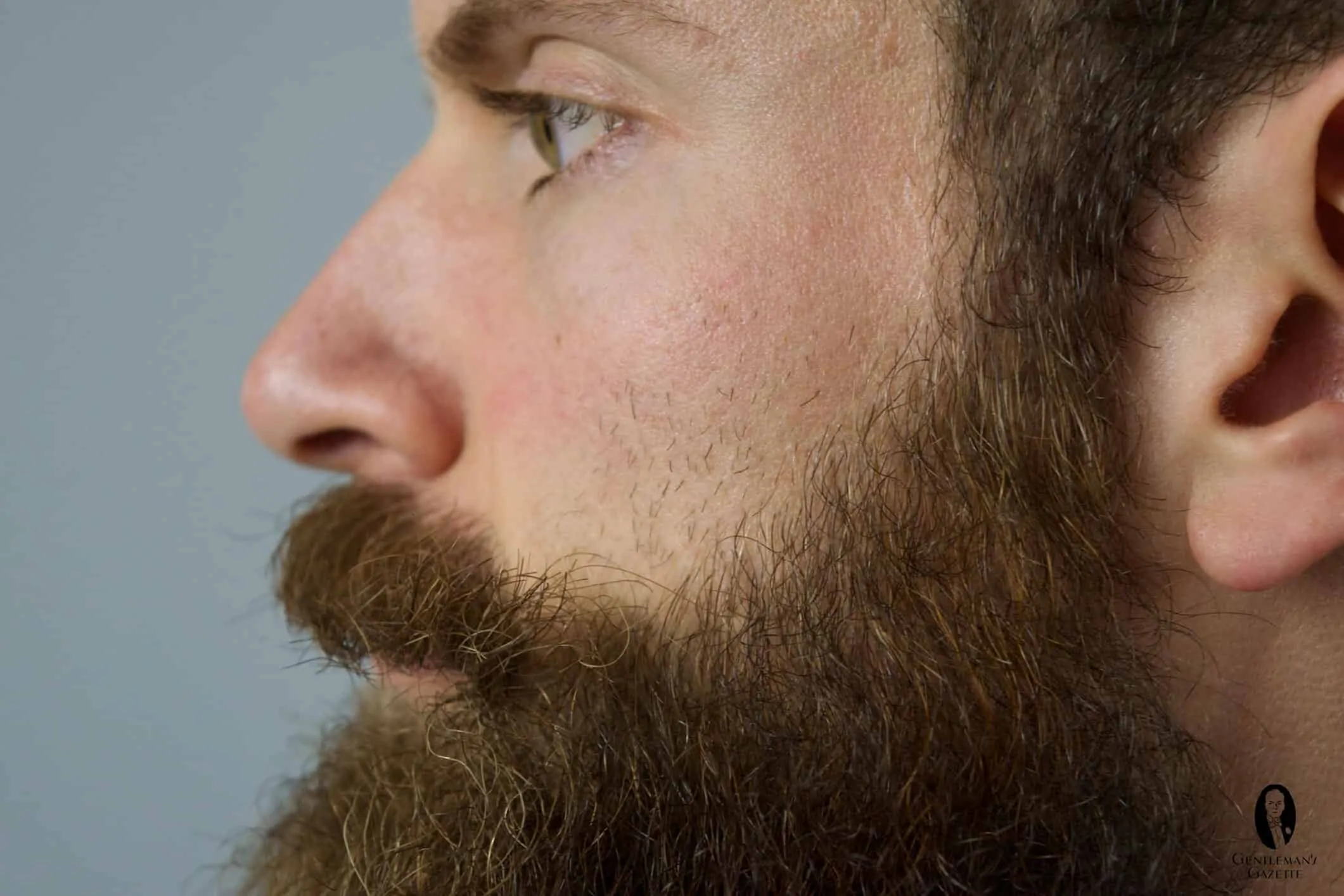
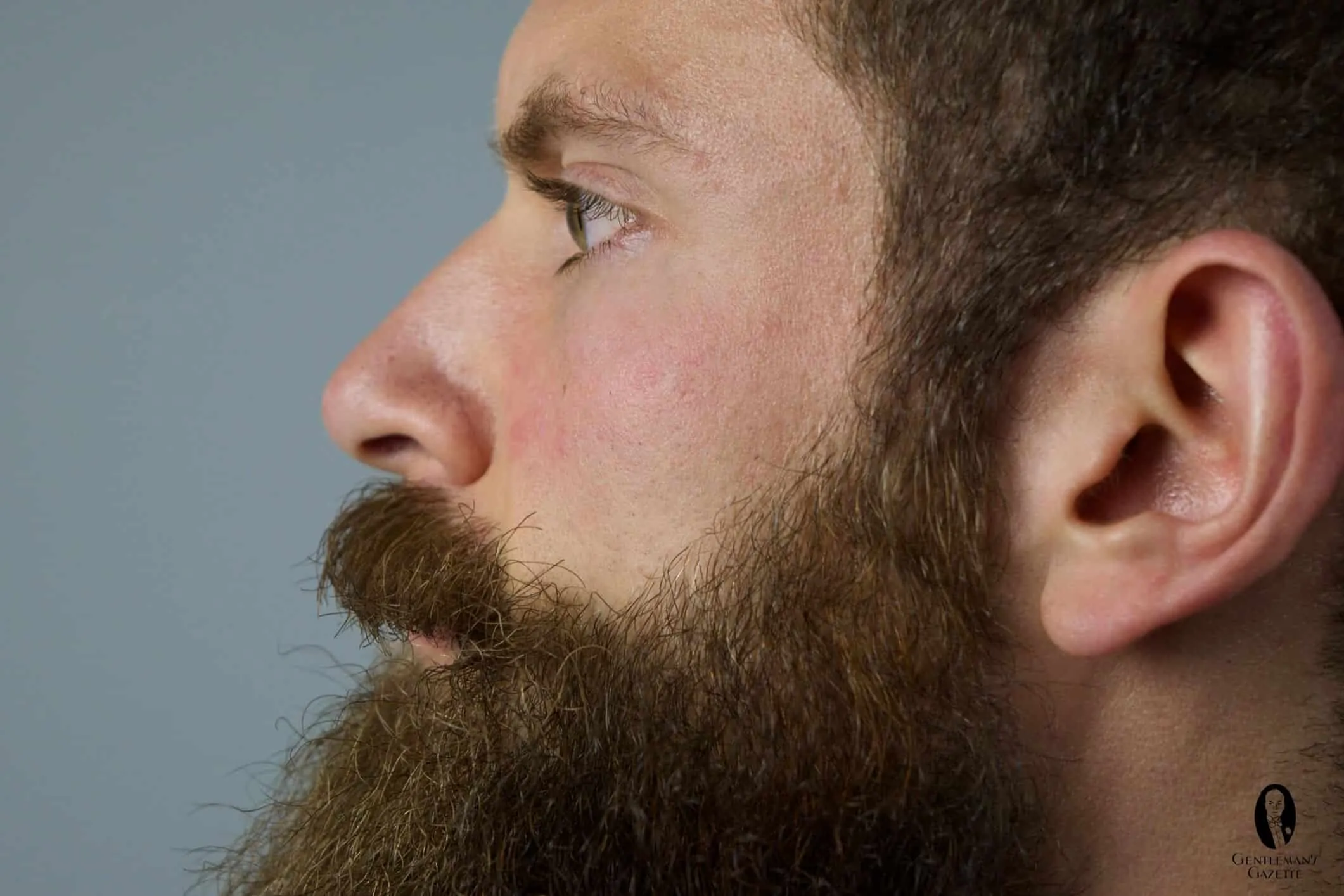
- Before starting, make note of the relative density of your beard hair around the cheeks.
- Start on the very periphery, which should have only a few stray hairs. Shave them away or cut them with your beard shears.
- Remove all of the stray hairs until you are left with a dense bulk of beard hair with a naturally occurring line between your cheek and the main mass of your beard.
- You want to create an organic transition from smooth cheek to dense beard. This allows for a much more natural-looking beard, as if your hair just grows in perfectly, rather than in a harsh, manicured line.
- A softer, more natural transition at the cheek line will also obscure stubble as it grows in. Sharp, artificial lines often cause stubble to stand out.
- Remember that your cheek lines do not need to match each other exactly. In fact, perfectly matching cheek lines, like a perfectly symmetrical face, will look unnatural and off-putting.
- You will likely need to shave or trim back your cheek lines every two to four days, depending your beard hair growth and personal preferences.
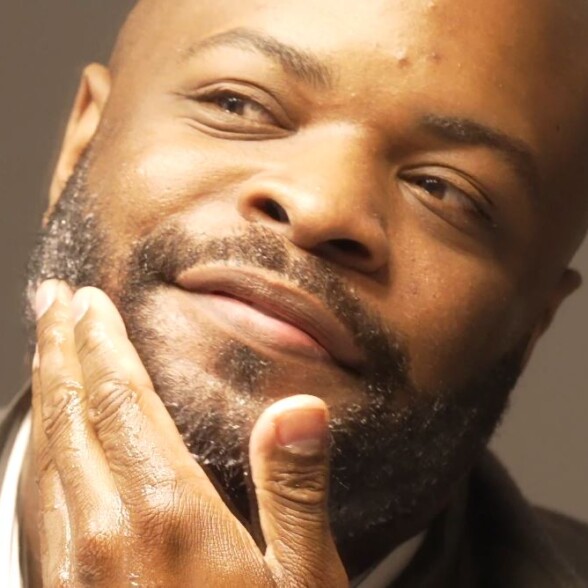
What if your cheek line still isn’t
Straight?
The fact of the matter is, no one has a naturally straight cheek line. Most men have a gentle curve to their natural beard line, and so it’s best just to clean up what you have. Furthermore, a lot of men have a gap near their laugh lines, meaning their cheek line does not go straight across from mustache to cheek. There’s no need to bring the cheek line artificially low to try to balance this; just do your best to clean up your natural beard shape. In other words, work your way down until you have a cleaned-up version of your natural hair growth.
If You Mess Up…
As with your neckline, errors when establishing your cheek line will be naturally resolved by the steady growth of new hair. Do not attempt to fix the problem by cutting away more hair deeper into your beard, as this usually only makes the problem worse and will require even more time for new growth.
Preparing to Trim Your Beard
Before trimming your beard, it’s important to go through your normal grooming routine. This is especially important if your beard is at all curly or longer than 1- 2 inches / 2.5 – 5cm.
Do’s and Don’ts When Preparing to Trim Your Beard
Don't trim your beard after sleeping on it
While sleeping, your beard becomes flattened and frazzled. You need to loosen the hairs and work them into a more malleable texture before attempting to trim to ensure that your cuts are accurate.
DO wash your hair
Washing, conditioning, and fully drying your beard will ensure that your hair is clean and manageable, making it easier to trim.
DON'T trim your wet beard
If your beard is wet or otherwise straightened and elongated while trimming, you’ll find that you end up taking off way too much after it dries.
DO apply beard oils as normal
If you usually wear beard oil, put it in your beard before trimming. This will not only make the beard hair softer, it will give you a better idea of what your beard actually looks like with the oil in it.
DON'T excessively flatten or fluff your beard
You want your beard to appear as natural and neutral when trimming, because that is how it will be once the trim is complete.
DO wait an hour or more after prepping your beard
After completing your normal grooming routine, allow your beard to dry for up to a few hours, and then run a wide tooth comb through it as you would during a midday refresher. This gets your beard into its “average” shape, neither messy nor overly fluffed out, allowing for the most reliable trim.
Steps To Trimming a Short Beard at Home
Defining a Short Beard
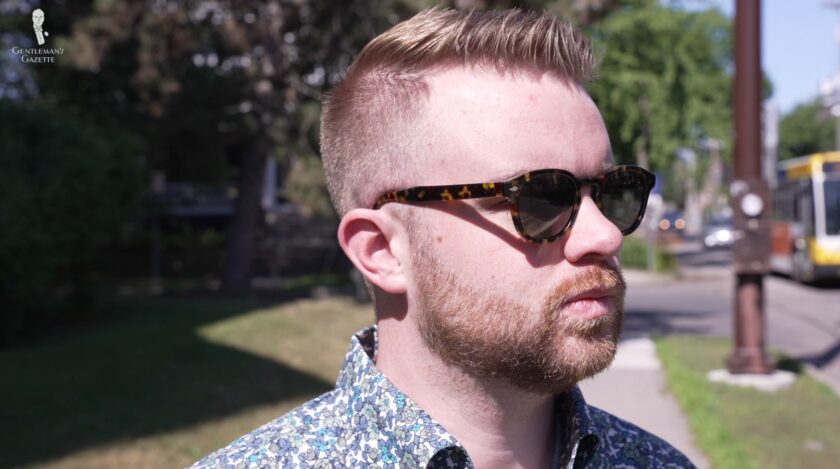
A short beard is any beard that is less than 1 inch long, although depending on your hair texture and growth, beards with up to 2 inches of length may function similarly to short beards. If your facial hair is longer than two inches, however, you definitely have a medium or long beard and should consult the relevant sections below.
Trimming a Short Beard
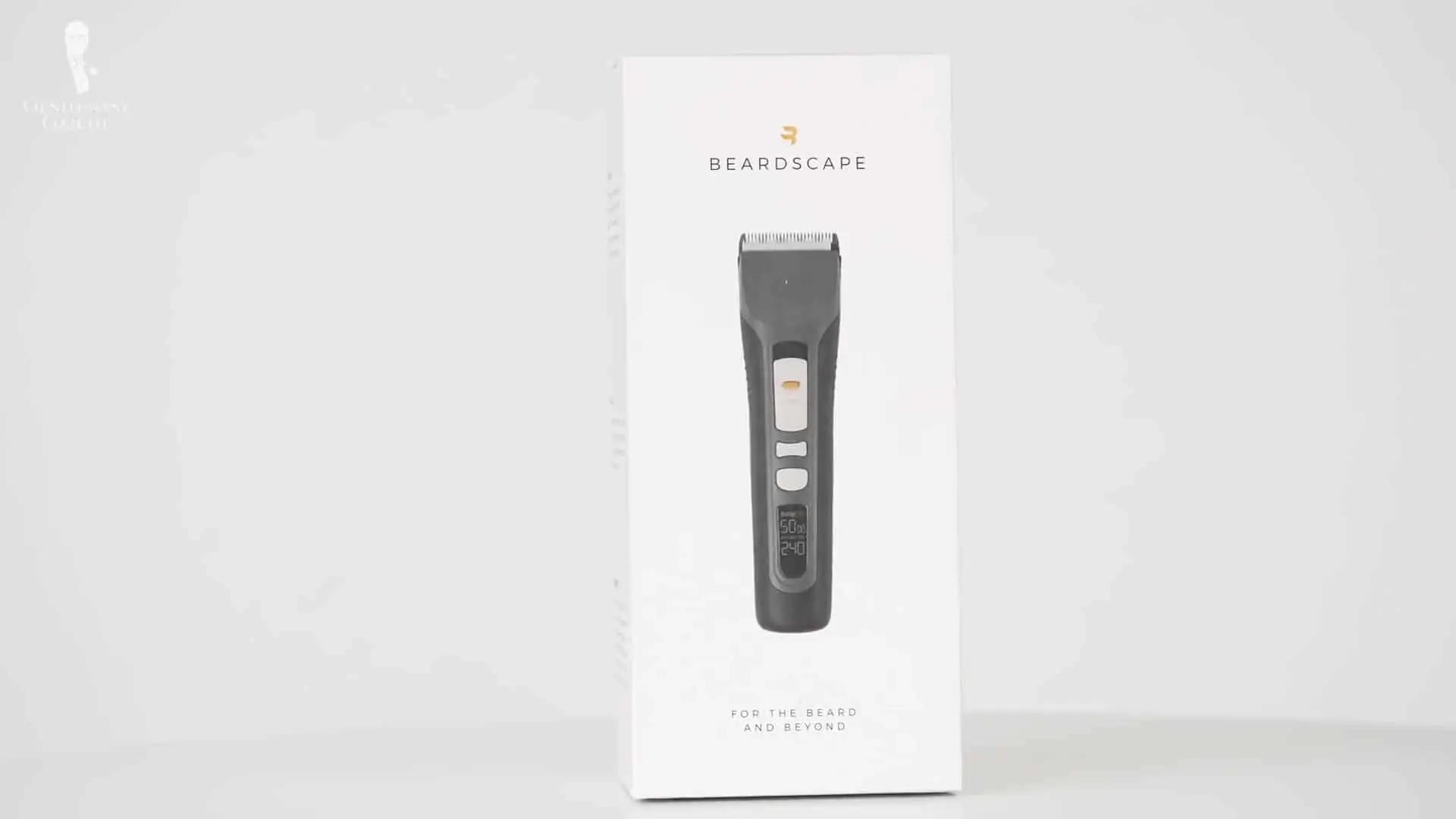
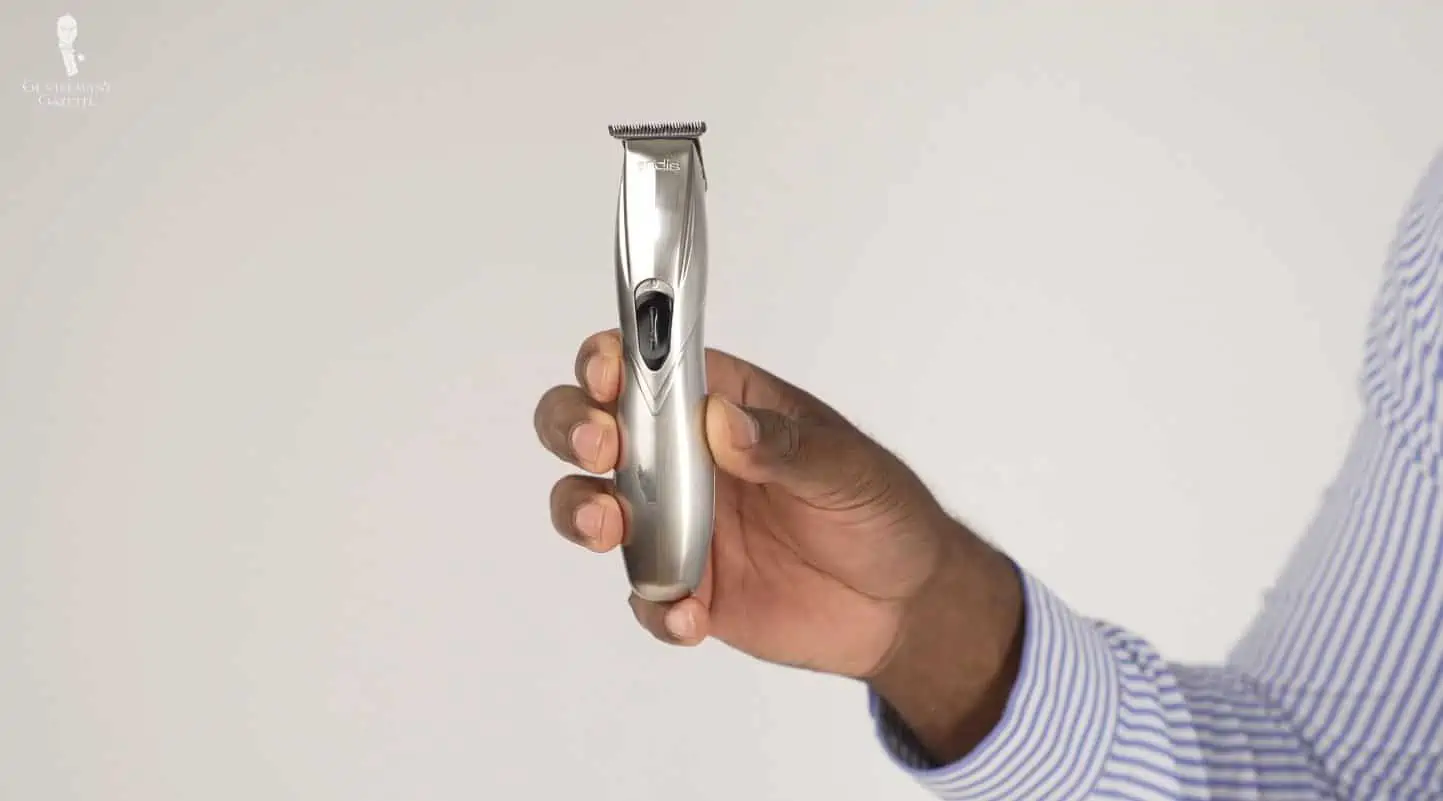
Trimming a short beard is an entirely different task than trimming a long beard. Unlike a long beard, you don’t have to worry about proportions, tapering certain areas, or accounting for the curliness of your hair. Cutting each beard hair across your face to the same length will serve you well. This means a beard trimmer is going to give you the fastest and most consistent results.
- First, establish or re-establish your neck and cheek lines as discussed above.
- Select the correct guard for your beard trimmer. When selecting a guard, begin with a bigger guard that is two or three sizes up from your desired length and run it through your beard on the trimmer.
- If you don’t hear it cutting, select the next size down and try again. You can also run just the guard through your beard to quickly assess whether it’s near the correct size or not.
- Continue moving your way down through the guards until you find one that produces the desired length.
- Use this guard to trim your entire beard, running it against the grain in a long, sweeping pattern.
- You’ll know you have everything trimmed evenly when you don’t hear the clippers cutting anymore.
- Once you have completed the process and you’re happy with the length a particular guard produces, just mark it so you can quickly grab the right guard the next time you trim.
If You Mess Up…
The good thing about making a mistake when trimming a short beard is that it will not take very long for your hair to grow back. If possible, even out your beard by shaving the hairs closer than you might otherwise prefer, just enough to hide or reduce the appearance of any mistakes. Then, simply wait for the hairs to grow back. Learning how to trim your beard while it is short and easier to fix is great practice for trimming your beard should you decide to wear it at a longer length.
Steps To Trimming a Medium or Long Beard at Home
Defining a Medium or Long Beard
![Sir John Leng 19th-century Scottish newspaperman and politician Sir John Leng definitely has a long beard. [Image Credit: Wikimedia]](https://www.gentlemansgazette.com/wp-content/uploads/2022/10/Sir_john_leng.webp)
A medium or long beard is any beard with facial hair longer than 2 inches. Whether your beard is medium or long will not affect the general steps that you will employ when trimming it.
While trimming a short beard is relatively easy, trimming a long beard requires a little more thought and consideration. Not only are the techniques involved more complicated, but the stakes are also higher. Considering the fact that you’ve likely just spent six months to a year growing out your beard, you’ve more than likely become quite attached to it.
Deciding Between a Beard Trimmer or Beard Shears

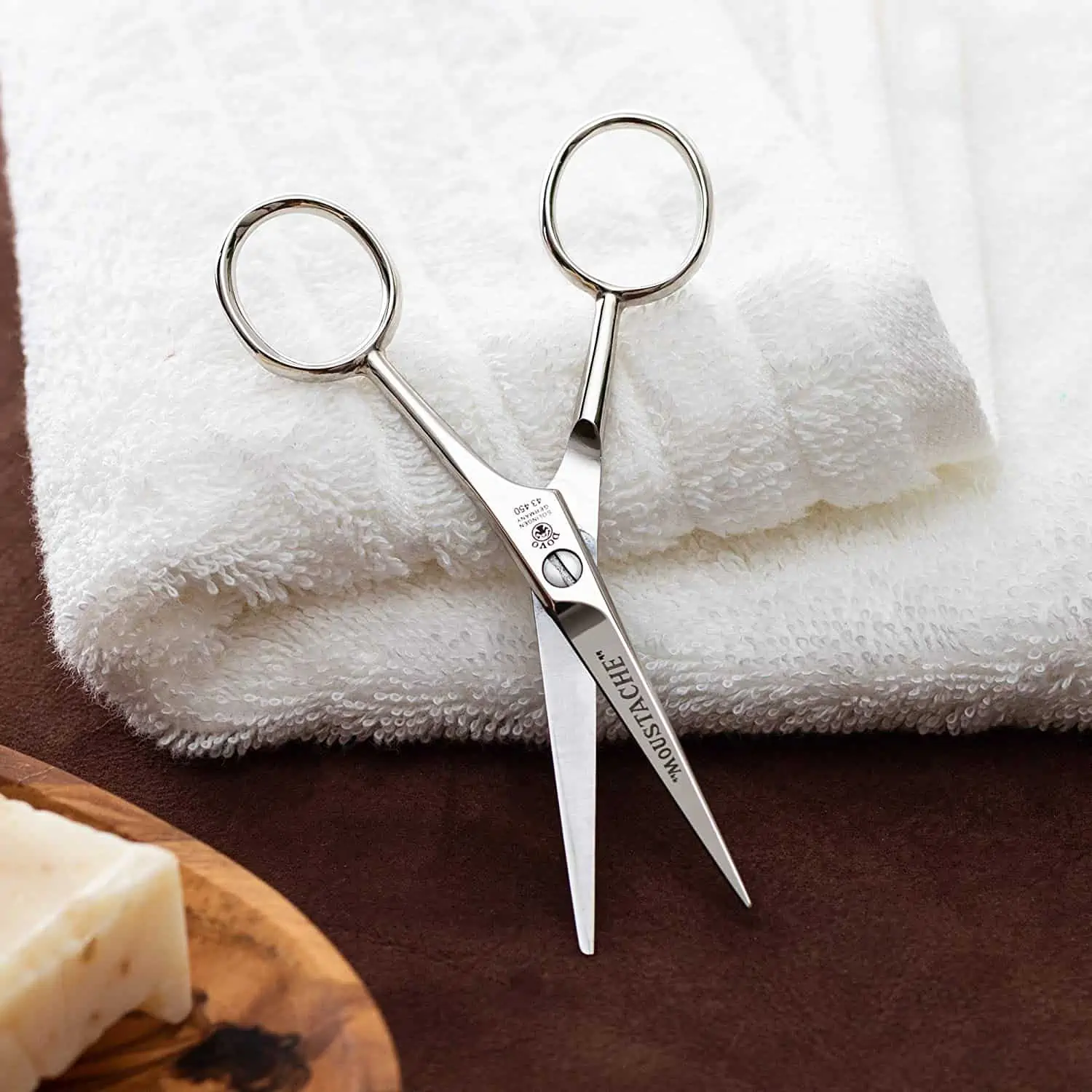
As previously mentioned, the following trimming of a medium or long beard can be done with either a beard trimmer or beard shears. A beard trimmer will be more efficient, but be sure to work carefully, as a misstep could hack out a chunk of your beard. Conversely, using beard shears will likely take longer but will minimize the results of any mistakes
Achieving a Full-Beard Shape
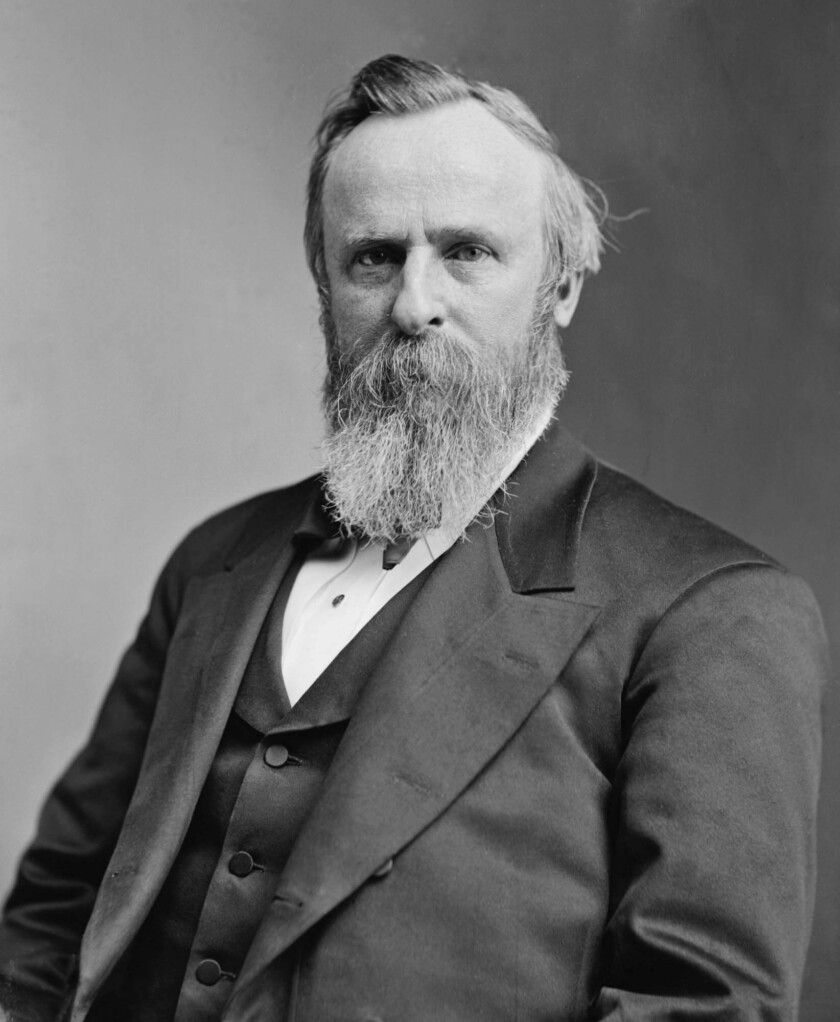
There are far too many facial hair styles to choose from to explain how to shape each one in detail. Since this is an article on how to trim a beard, a standard full beard will be assumed as a default, and you can adapt the methods and techniques to your unique style.
But typically, a well-groomed full beard requires a few general shape requirements. In the most simple terms, shape your beard so that it follows the shape of your jaw while being slightly heavier near the front. That means that it’s longest near the front and bottom, around the chin, and shortest near the top and back, around the sideburns.
As you are trimming, avoid the temptation to pull your hair taught with a comb and cut at its perimeter. This will result in a “divot” as soon as you release the section and the hair retracts to its resting length.
Trimming the Vertical Lines
The vertical lines of your beard are effectively the left and right sides beyond your cheeks. While those desiring a more boxy beard can cut these lines effectively perpendicular to the floor, a slight curvature will look more natural and is preferable for most men.
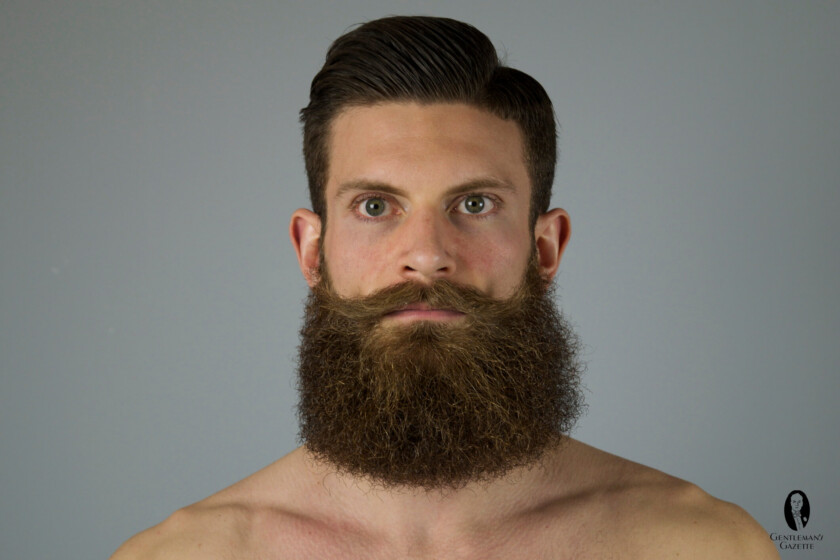
- Begin by trimming the vertical edges of your beard.
- Start around your sideburns and trim along the side of your face on a flat plain.
- Do not trim around the curve of your neck, as this could spoil the work you did while cutting in your neckline.
- If desired, take your beard closer to the skin near your cheek line while leaving more width near the bottom for a tapered look. Turn your head to the side to get a good look at the area near your jaw muscle. A handheld mirror helps tremendously with assessing this area.
- Generally, you can trim your beard shorter near the jaw muscles while leaving it a little longer as you move forward.
- Once you’ve cared for the sides, trim around the front of your beard, snipping any of the strays or unwanted bulk that projects out in front of your beard. Again, a mirror will help you accurately assess your beard from the side.
Trimming the Horizontal Lines
The horizontal lines of your beard will determine the overall length of your beard. As with establishing other lines, you will need to first determine exactly how long you want your beard to be. Unlike cheek or necklines, however, overall beard length is entirely your choice, although you should keep in mind that longer beards will generally require additional care and attention.
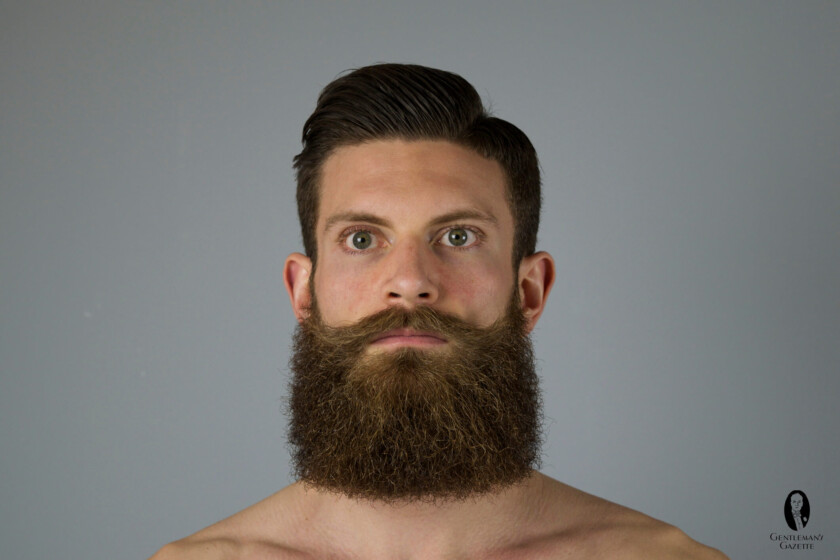
- After determining your desired length, begin gradually trimming upwards from the horizontal line that will be the bottom of your beard.
- Remember to trim horizontally and do not cut “into” your beard.
- Start with the long hairs protruding out of the densest portion of the beard.
- Then assess the overall length. If you want to take off more, go back and cut about 1/4-inch / about 0.5 cm from the overall length.
- Take the time to assess and then repeat the process until you’re satisfied with the length.
- Before finishing, consider taking a little more off the bottom near your neck. This will help form a slightly front-heavy beard.
Rounding the Corners
By now, you should have a beard that resembles a cube. Unless this is the look you’re aiming for, it’s time to round the corners, or in other words, shape the jawline. There really isn’t a lot of technical information to give here. Just gradually trim your beard hairs until you have a natural-looking, gentle transition from your vertical to a horizontal line. Remember that while you want all of the portions of your beard to be roughly symmetrical, do not try to make them perfect. This will be almost impossible to achieve and will not look natural.
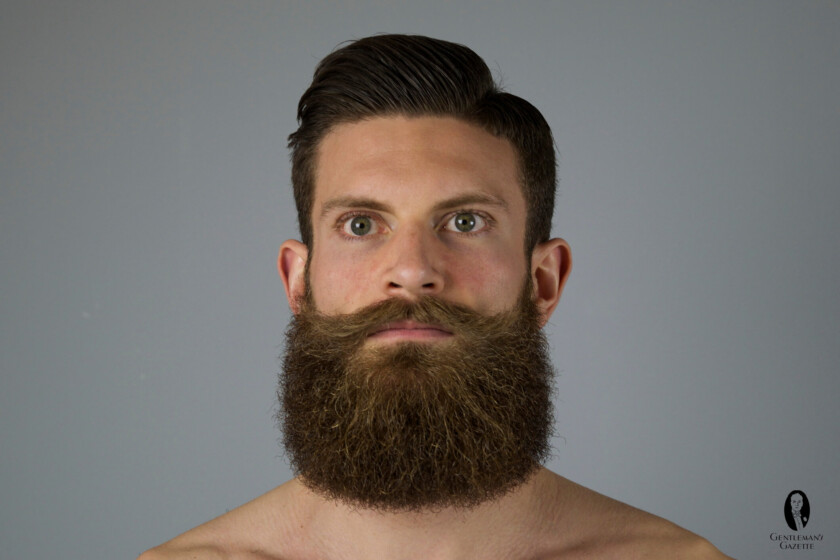
- Many men prefer a slight point at the lowest termination of their beard to avoid an unnatural, blunt stump.
- Holding your scissors parallel to the floor, very carefully shape the tip of your beard by snipping away extremely short portions of hair.
- Do not focus on sharp lines or precision, as you want this point to appear soft and natural.
- At this point, you should use your beard shears to trim away any flyaway hairs that might be poking out.
- Brush or comb your beard one more time, and style it if desired.
If You Mess Up…
It can be very frustrating to damage your medium or long beard while trimming, especially if you have dedicated a considerable amount of time to growing it. One benefit of longer facial hair, however, is the fact that you have more hair to work with to correct the error. For instance, you could potentially shave away your long beard to a medium or short length to hide any evidence of the mistake, and then simply wait for the long beard to grow back to its former glory.
Steps To Trimming a Mustache at Home
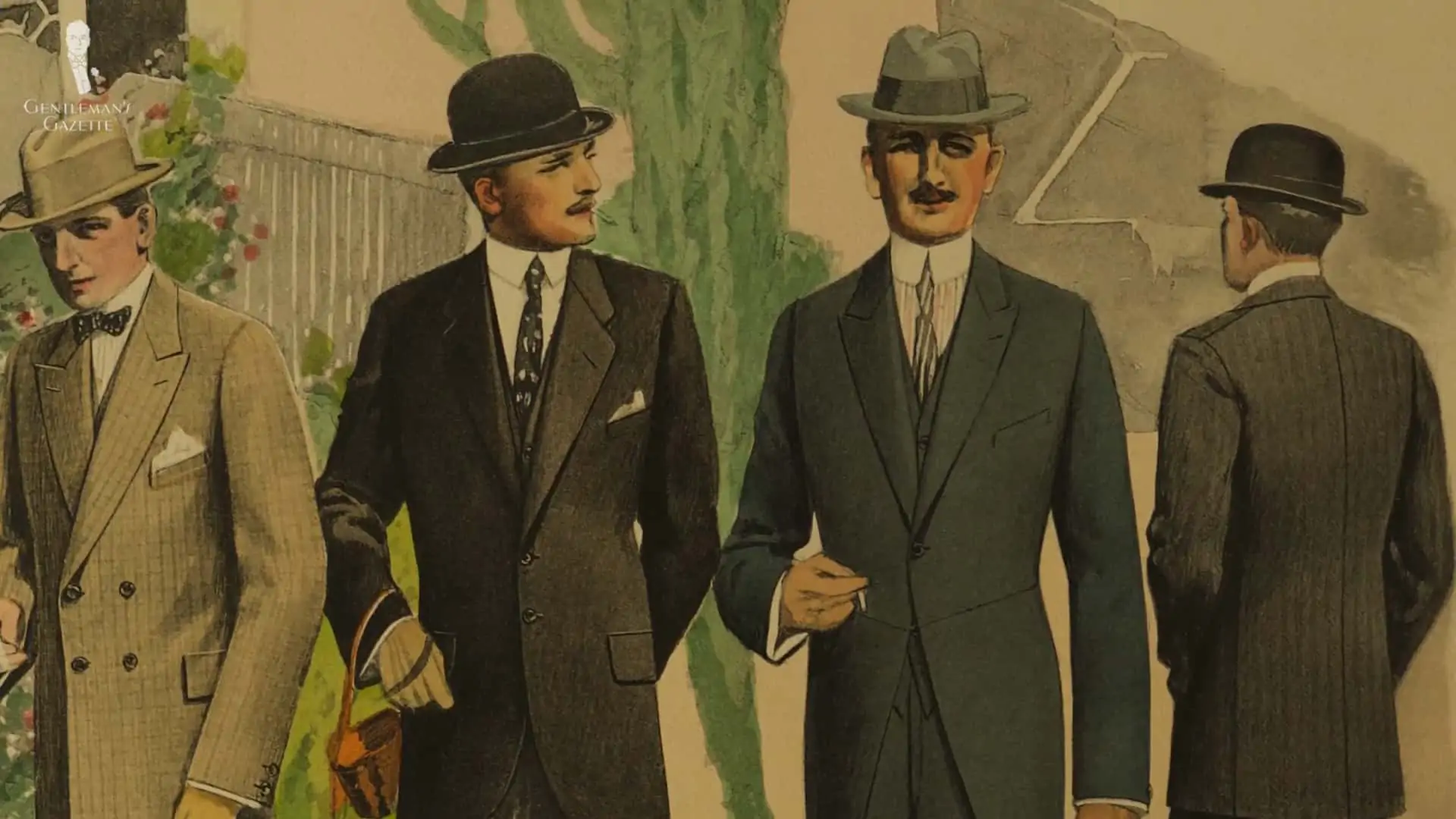
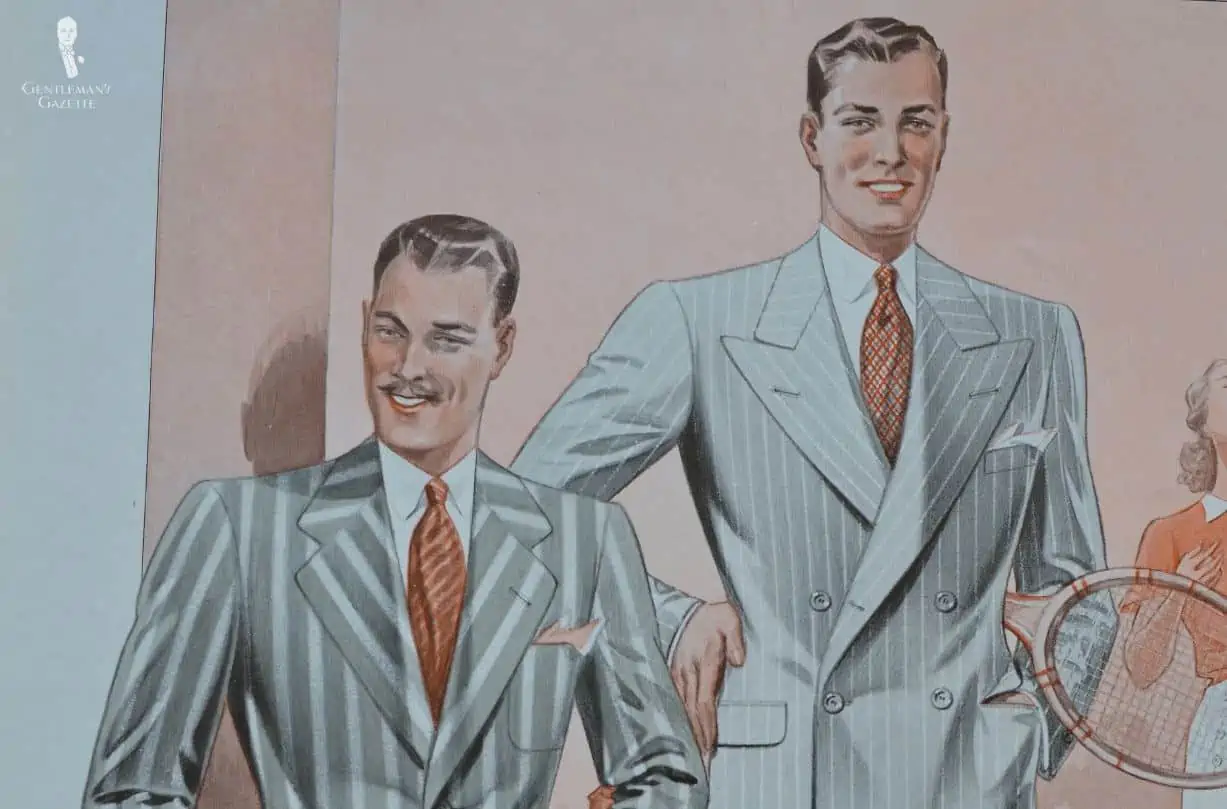
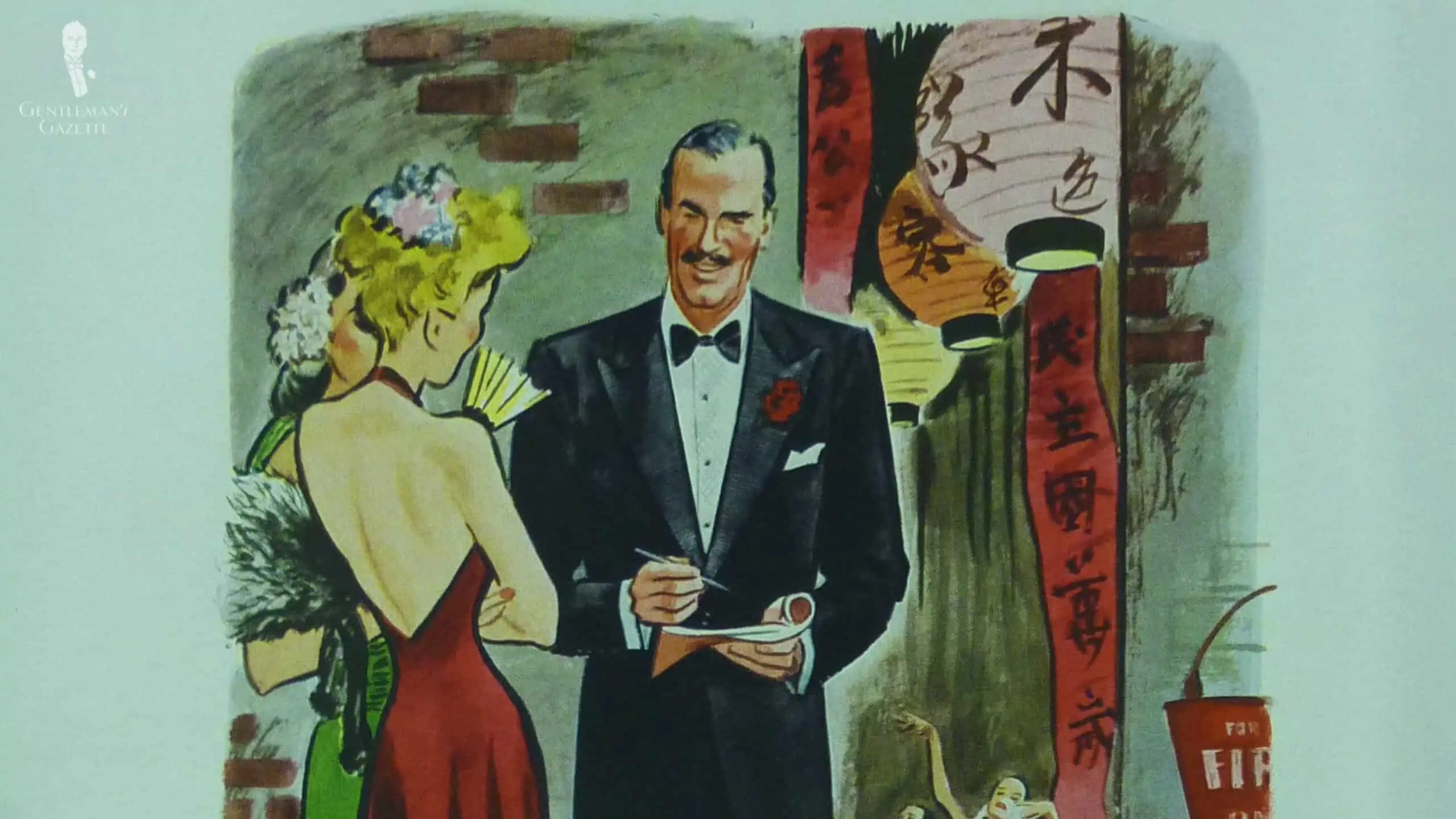
For most men, regular mustache trimming will be necessary to ensure that mustache hairs do not get in your mouth, food, or drink, and to prevent the hairs from pricking your lips.
Most men will need to start trimming their mustaches after four to five weeks of initial growth, but you should begin trimming as soon as mustache hairs become an inconvenience to you. After this initial trimming, continue to trim your mustache as needed.
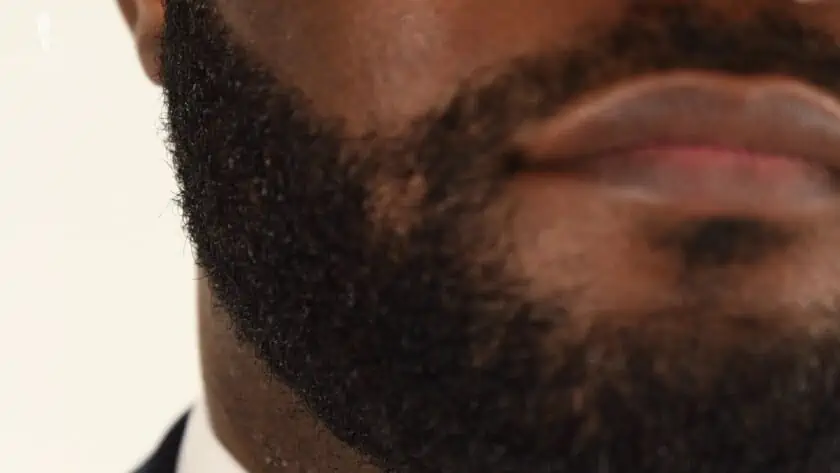
- Using a beard trimmer, remove the guard and carefully trim away hairs directly above your lip.
- It’s best to take off a little at a time and work your way up to avoid taking off too much.
- Follow the natural curve of your lip and keep an equal distance between the top of your lip and the bottom of your mustache.
- Remember, the ends of your mustaches should not match each other perfectly. Do not go back and forth removing hair in an effort to make them match perfectly, as this can quickly cause you to remove too much of your mustache.
If You Mess Up…
By moving very slowly and carefully, it is likely that any minor misalignments or excess hair removal will be very difficult to notice. Therefore, you can simply wait for the mustache hairs to grow back. If you do end up cutting so far into your mustache that it is very noticeable, it might be worth it to shave off the mustache and start over again. Only you can make this decision, but take heart in knowing that mustache hairs tend to grow in fairly quickly, so you should be back where you started within a month or so.
Weekly or Biweekly Maintenance Trimming
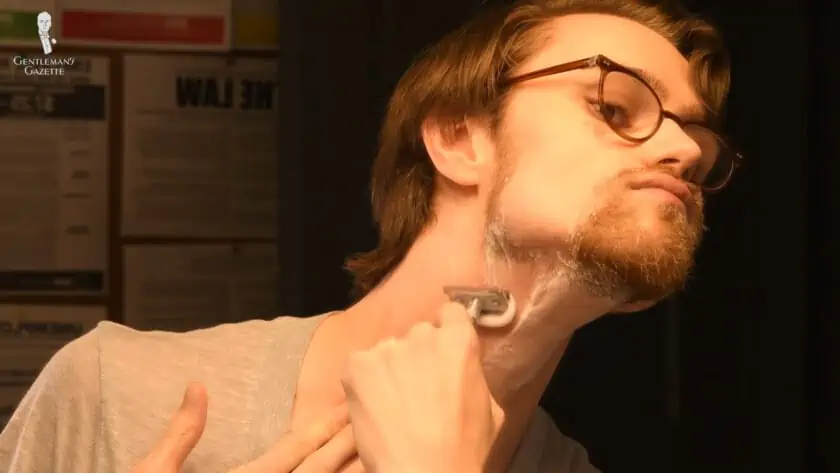
Occasional maintenance trimming of your beard every few days or once a week will allow you to reduce the number of times that you have to undertake more extensive trimming sessions. Simply follow these basic steps, which utilize the techniques you learned above.
- Use your beard sheers to maintain a neat, even edge around the bottom of your beard by removing flyaways, stragglers, or excessive growth.
- Trim mustache hairs with beard shears or a beard trimmer if they start to encroach over your upper lip.
- Maintain your neck and cheek lines by shaving around them with your razor, preventing new growth outside of those lines for as long as possible.
The Benefits of the “Patient Trimmer” Method
Gentlemen with especially dense or thick beards may find that while their beards look exceptional immediately after trimming, the overall effect is precipitously diminished after just a day or so. This decline in appearance is the result of natural beard growth that can quickly spoil the overall lines of your beard.
One solution is the “Patient Trimmer” method, in which scissor work is spread across several days to arrest outlier hair growth as it occurs. Consider adhering to the following schedule:
Day 1: Rough out the shape, getting it about 90% of the way to perfect.
Day 2: Spend a few minutes trimming any long hairs that poke out from your desired outline
Day 3: Spend a few minutes trimming any long hairs that poke out from your desired outline
Day 4: Spend a few minutes trimming any long hairs that poke out from your desired outline
Conclusion
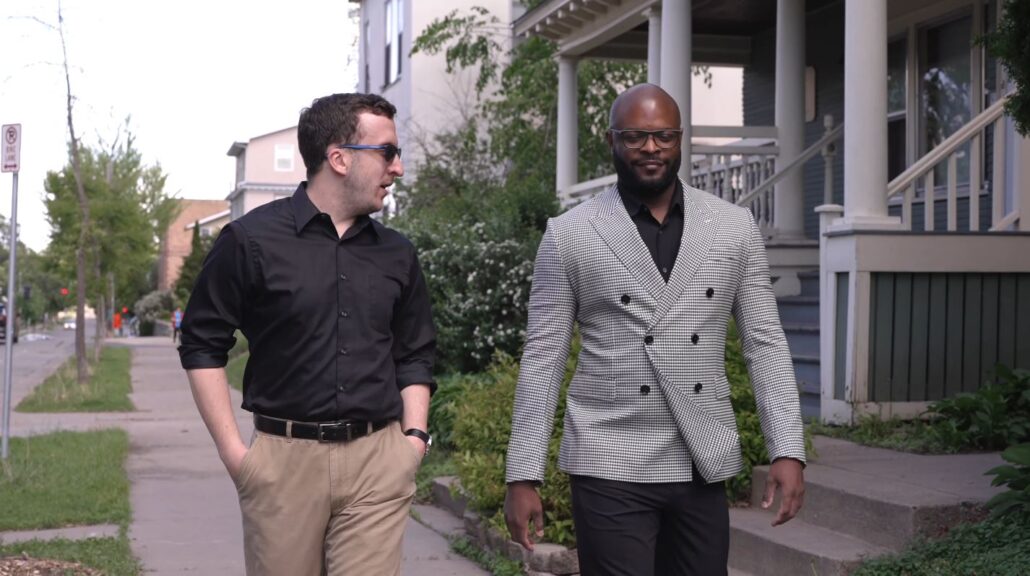
Thanks to the tools you have learned in this guide, you are well-prepared to handle all of the aspects of trimming your beard at home. Facial hair might not have been the most popular style during the Golden Age of Menswear, but with your meticulously cut and elegantly styled facial hair, we know that your beautiful beard will be the perfect addition to today’s Classic Style scene.
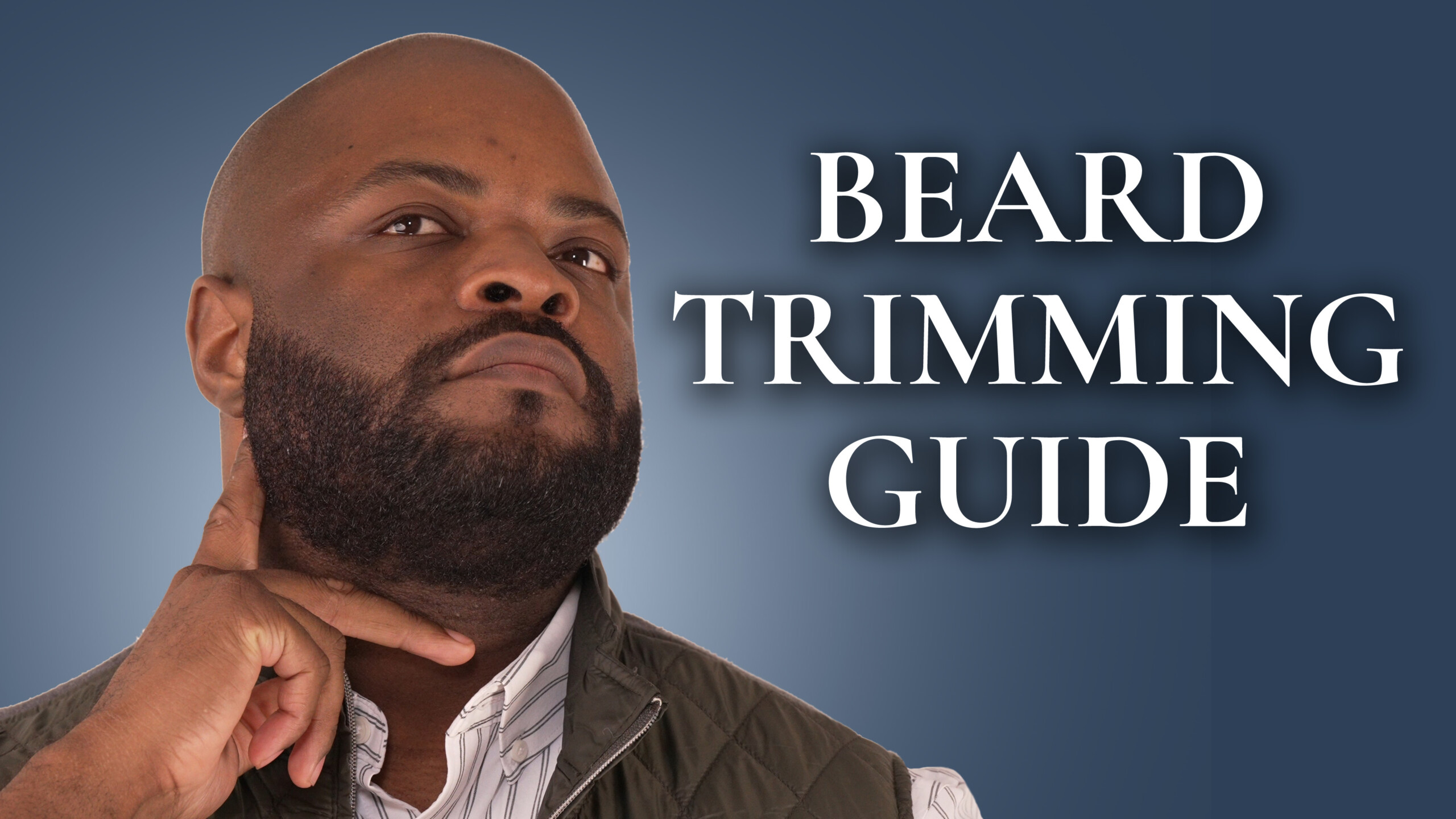
This is awesome. Thank you! I grew out a beard end of last year / early this year. About 6 months. I got the lion look and didn’t know what to do with it. My wife suggested the comb out with trimmer trim, and omg it freaked me out because it behaved as you said where it fell back in, in divots. It looked short and my confidence went down , So I left it and just left it until I had a job interview. I want to grow it back out but the maint and trim is what I’m nervous about. Any chance for a video?
Thank you!
Stephan
Amazing Post!
Liked the information regarding the cheek line and neckline :D
I have been growing beard since last 7 months, any tips on increasing the length of beard?
Would like a handlebar mustache guide